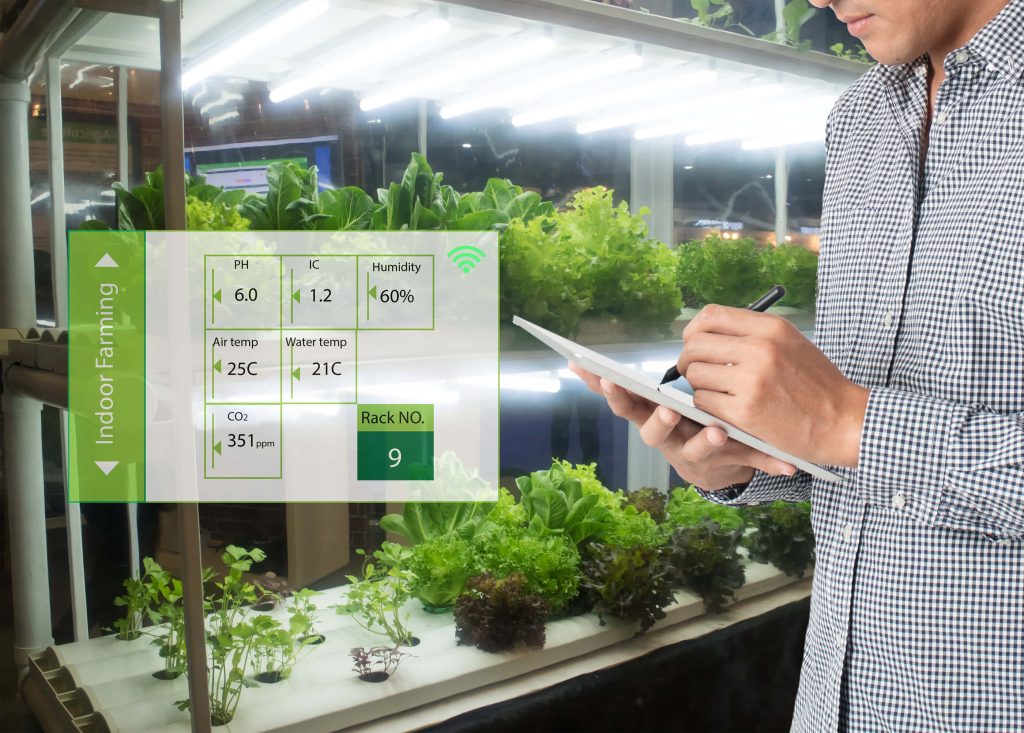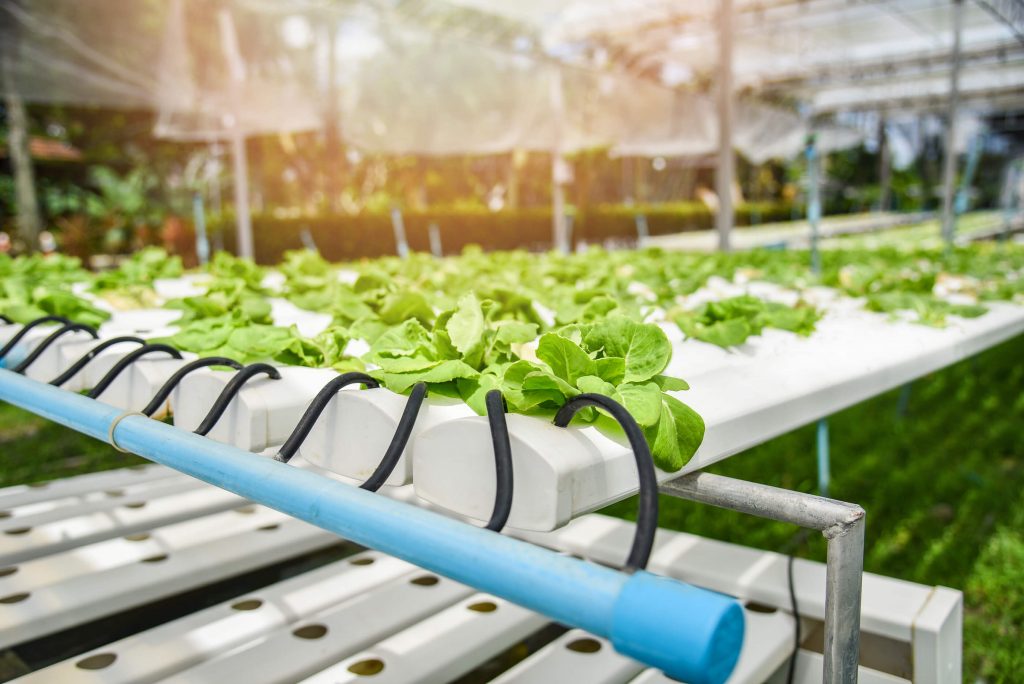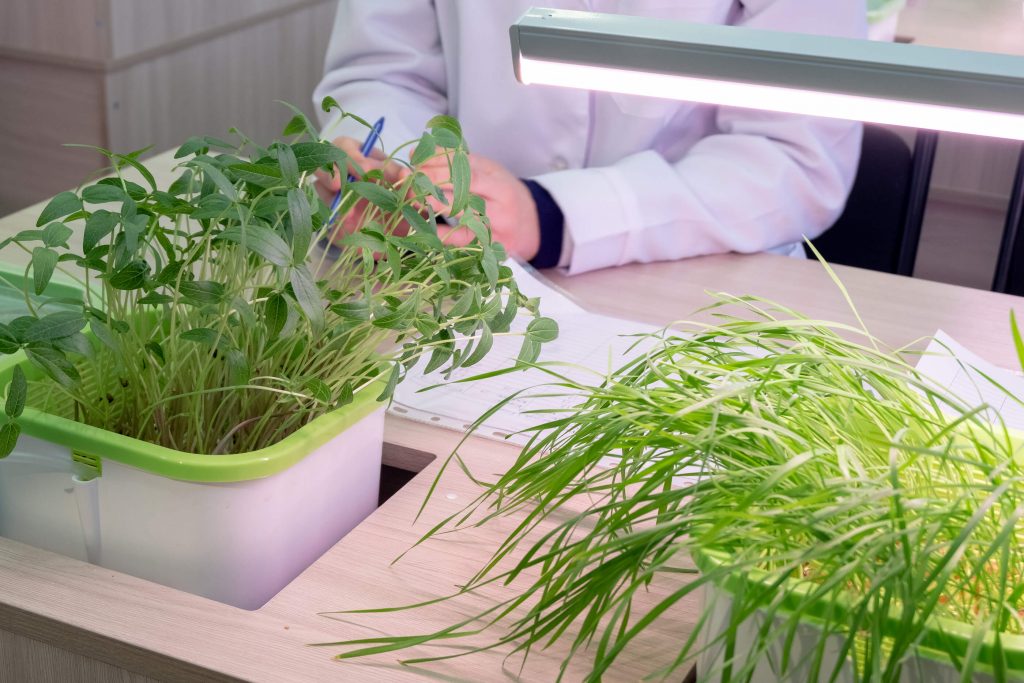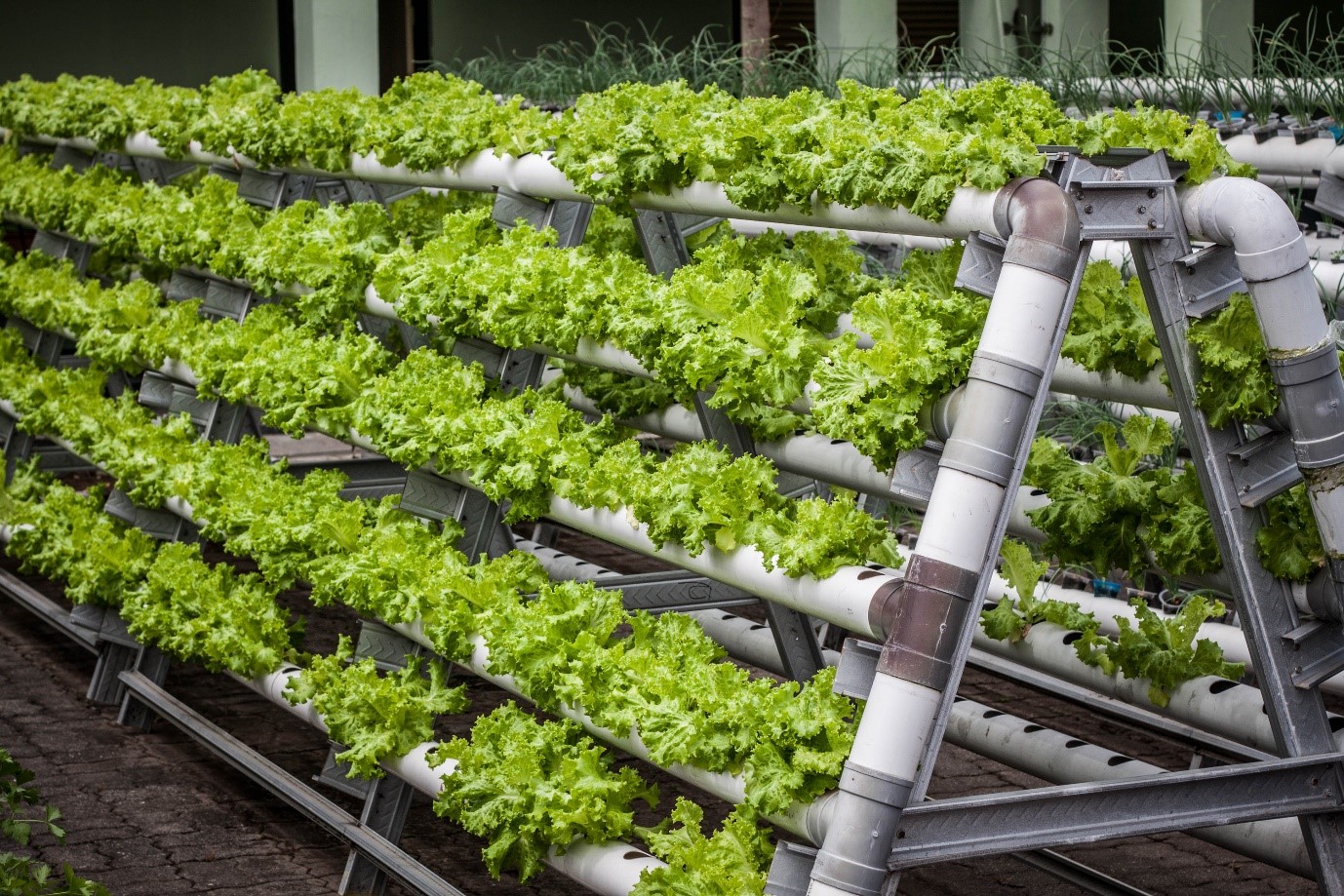Farming first emerged more than 11,000 years ago, and it seems that apart from the birth of industrial agriculture in the 20th century, and other technological advances, very little has changed since. With alarming environmental crisis and ever-growing global population, however, it is clear that humanity has been feeding itself in both a destructive and unsustainable way, to the point where a new solution simply must be sought.
Although the term “vertical farming” was first used more than 100 years ago in Gilbert Ellis Bailey’s book Vertical Farming, which focused on soil quality and nutrient density, the modern-day definition refers to growing plants in vertically stacked layers. The stacking can be used on a small scale for domestic use, or large-scale commercial farming in skyscrapers or warehouses.

Vertical farming is a smart concept, in which produce is grown in vertically stacked layers and in vertically inclined surfaces called hydroponic systems. So-called high-tech vertical farmers use natural sunlight or LED lights, and technology to monitor and adjust atmospheric humidity, water level, nutrients, and harvesting times.
Roots of vertical and urban farming

Two decades ago, ecologist Dickson Despommier of Columbia University planted the seed for vertical and urban agriculture by promoting the idea of farming in skyscrapers, after asking his students to find a solution to feed the population of Manhattan.
The students tested rooftop gardening as a solution but found that this approach would only supply two per cent of Manhattan. Disappointed with the results, Despommier came up with the unconventional idea of marrying farms and cities by farming vertically — indoors.
This approach adds another dimension to the saying “concrete jungle”, as opposed to architect Ken Yeang, who proposed and built mixed-use skyscrapers for personal and community use, Despommier promoted skyscraper farming for both wholesale and distribution.
In 2009, the UK became the pioneer in testing the vertical farming system, carrying out research at Paignton Zoo Environmental Park, where staff grew food for the animals and recorded the results.
Three years later, a company in Singapore piloted the first commercial vertical farm, which totalled three stories in height, and since its inception, has expanded to more than 100 vertical farming towers.
Today, vertical farming has its own Association for Vertical Farming, founded in 2013, and is responsible for advancing vertical farming technologies and hosting international workshops and information days.
Many farms are finding a place in former shipping containers turned greenhouses, skyscrapers, abandoned factories, and disused warehouses. AeroFarms, named as one of the world’s most innovative companies by Fast Company Magazine, has even used a converted night-club for plant growing.
In 2017 IKEA alongside other investors put $40 million in AeroFarms, which are now building the world’s largest vertical farm in Dubai.
Critiques may say that farming in the city is expensive, but this is something that Despommier dispels, as urban farms can be placed in the periphery of cities, where it is significantly cheaper to implement.
Dubai is also a great example, as the city heavily relies on food imports, and indoor farming can be a much more sustainable and cost-effective way of getting produce to the market.
Costs are also offset by the fact that there are lower transportation, water, and energy expenses. A great example is Whole Foods Market in New York, which sells produce grown in a vertical farm upstairs from the grocery store, making the produce as fresh as possible.
This is a great example of the cost-effective proximity to the consumer. FarmedHere, a commercial vertical farm currently supplies all of Whole Foods Market stores across the Chicago area.
Types of vertical farming
Conventional farming is highly dependent on seasonal weather conditions, which can be disruptive, as only certain vegetables can be grown at certain times of the year. With vertical farms, lighting, temperature, and water can be optimised to enhance production rates, improve product quality, and increase nutrient density in produce. The soil used in many instances is not used, and crops are grown in membranes.
Multiple technologies and methods can be used for vertical planting and farming:
- Greenhouses, similarly, to skyscrapers, can house indoor vertical farms.
- Folkewall is a Swedish concept nowadays commonly found around the world; it involves purifying greywater by growing plants on building walls using wastewater.
- Aquaponics is a commercially used vertical farming method, a technology that combines plant farming and aquaculture in an integrated system. In this method, fish waste serves as a fertiliser for plants, and in return, the plants purify water for the fish.
- Hydroponics is one of the most notable indoor vertical farming methods; combining plant growing in water management systems, and energy-efficient LED lighting. Plant roots grow in a sponge-like material, which is soaked in nutrient-dense water.
- Agricultural robots are the future replacement of human farmers in all stages of plant farming. The latest model robots such as Iron Ox ones can measure temperature, humidity, air quality, nutrient levels, as well as plant seeding, inspecting, and harvesting.
- Aeroponics is the upside-down version of hydroponics, as the plant roots hang freely in the air, while a mist system sprays them with nutrients.
The fruits of vertical farming
There are several environmental advantages of vertical farming, which can solve a multitude of issues that face both society and the environment:
Natural land, flora, and fauna recovery
The vertical approach is space and land-effective, which consequently leaves more room for trees, plants, and land, so that it can return to its natural state; reversing deforestation and offsetting CO2 emissions.
Hydroponic farming also makes the harvest organic, which means that chemicals do not harm the soil and organisms inhabiting it. Restoring the natural environment that has been replaced by farms could adverse effects of conventional farming, such as mass extinction of small animals.
Lower risk for health and safety

The vertical farming practice also poses less health and safety risks for humans. Traditional farming exposes farmers to the previously mentioned chemicals used in agriculture, microbes, injuries, and, depending on the area, dangerous forms of wildlife.
If vertical farming is integrated into mixed-use buildings, it purifies the air and improves its quality, therefore providing health benefits for any community using the building.
With technological advances, smart agricultural robots could replace human labour and increase efficiency at the same time.
Low water consumption

Proper hydroponic garden management produces year-round produce and solves the issue of water shortage, high emissions, and high energy usage. The technique also has the potential to save us from global starvation, as the water use is very limited and closely monitored. Some vertical farms even collect the water that condenses and recycles it in the greenhouse environment itself.
This is especially important now when the world’s freshwater reserves are running out. The Aral Sea, which used to be the world’s fourth-largest lake, has now been declared as completely dried out and mostly due to the extensive water consumption for conventional cotton production.
Low energy consumption and pollution
Several vertical farms are run using renewable energy, such as solar panels, energy-efficient LED lights, and reflectors. The technology-controlled method uses less energy, therefore produces less pollution. What’s more, vertical farms could be energy sufficient by generating power for the greenhouses through methane digesters built on site.
The proximity of vertical farms to the end consumer is a great benefit, as it cuts long-distance transport out of the supply chain, as well as substantially reduces spoilage and other pollution-related to transportation. Globally, almost a third to crops go to waste due to infestation and spoilage.
The controlled environment also enables farms to cultivate crops that would naturally struggle to live in a particular climate. By focusing on growing typically imported crops in vertical farms, UK food safety, security, and environmental footprint of the supply chain can be significantly improved.
The financial aspect of vertical farming
Although research shows that vertical farming is three to five times more expensive than conventional outdoor farming, technology is continuously evolving, and vertical farming is still a relatively new niche of farming.
Dr Paul Gauthier, a plant physiologist, specialising in vertical farming, predicts that the future is not in large scale vertical farming, but individual vertical farming. Much like Bill Gates had a vision of a personal computer in each household, Gauthier predicts that each home will have its integrated hydroponic source of vegetables and fruits.
Technological advances will help bring down costs associated with vertical farming, and vertically grown produce will be delivered to mass markets at a competitive price.
Although the land prices are higher in the city, farms could compensate by cutting energy costs by using residual heat and take place in multi-use buildings, sharing energy and artificial lighting with other users.
As the practice does not depend on seasonality, productivity is much higher too, enabling farmers to sell more and offset operational costs.
Although initial system installations might be costly, the automated water and nutrient systems will cut out the need for human resources, reduce spoilage, and assure the best farming conditions.
As the produce grown in vertical farms is naturally premium quality and nutrient-dense, as well as being local to the end consumer, it can be sold at a premium price too, which can compensate for the technological costs.
With process automation, the costs of human labour could be reduced, and employee efficiency increased. Currently, tasks like pollination and harvesting require a large workforce, as well as machinery to lift workers to each layer of the farm.
With agricultural robots becoming more mainstream, they could replace human workers and relieve the financial strain, enabling lower produce costs and selling to a larger market share.
Domestic vertical farming

If you already live in an urban area, do not dispose of a physical garden or allotment, but would like to produce your greens as locally as possible, you can create an indoor vertical evergreen farm.
Retail giants have already jumped on the vertical farming trend and offer affordable DIY kits for amateur gardeners interested in growing plans regardless of the season.
If you would like to have a go at vertical farming in your household, IKEA offers indoor hydroponic gardening kits with plant cultivation units and LED lights.
John Lewis offers vertical wall planters for growing flowers or edible plants that can be easily attached to walls, enabling any indoor space double up as a garden.
Those already owning a greenhouse can make it more productive by installing LED lights, which have significantly reduced in price in recent years. By removing soil and installing vertical hydroponic systems, you can expand your greenhouse to produce garden level volumes of leafy greens, flowers, and vegetables.
If you’re looking for a new business venture and planning on opening up your vertical farm in an urban area, take the hard lessons learned by those who have already tried and failed.
Make sure you define your consumer, choose the closest location to them, price your product according to with the quality, and exhaustively plan out your labour and technology investments.

Although critics may say the industry is very technology-reliant, so are even larger fields such as medicine, transport, and eCommerce. The growing interest in vertical farming could herald the future of agriculture. This innovative approach could relieve the strain on our planet’s resources.
Vertical farming could stretch even further and produce honey and fish; it is an excellent opportunity for social entrepreneurs to merge urban living with agriculture.
We can’t farm the way we have been, purposely destroying an ecosystem for food production, but with urban farming, we can continue to feed the planet sustainably.
With political tensions impacting export and import, growing everything locally is a solution to relying on produce in other countries. As Despommier puts it best, “food safety, supply, sovereignty, sustainability, those four S’s all matter, and vertical farming solves all of them”.
With technological advances and further research, vertical farms and controlled environment precision farming could scale down the costs, and account for more and more produce grown both domestically and for local wholesales around the world, providing a feasible alternative to conventional farming.

Here umesh from india . This is very informative article . I think in future growing of pollution and population it’s making requirements of vertical framing . But a common Farmer are not able to develop the technology and this system they have not financial support . But most of them do this .
Nice farming